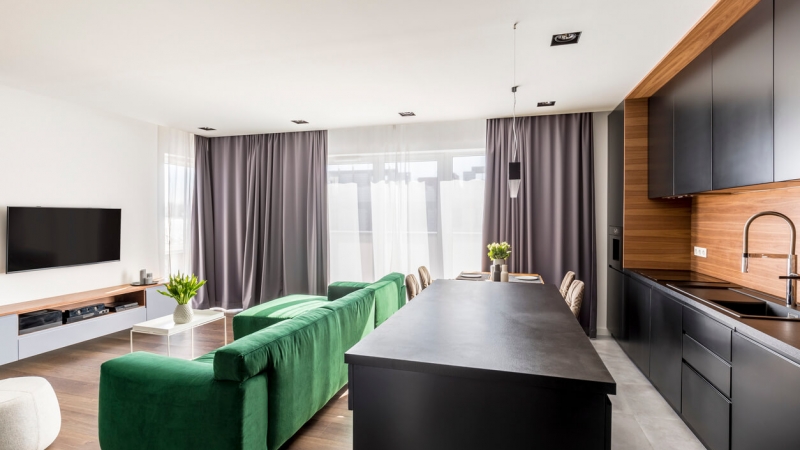Hotel interior design is of vital importance when it comes to creating a positive experience for your guests, planners and their attendees, your staff, and anyone else who steps foot into your property. The design of a hotel represents the audience that you’d like to attract, communicates your brand promise, highlights all of the amenities that you offer, and much more.
But hotel interior design is about more than sleek lines and expensive furniture. So, we put together this guide, which includes 10 expert tips and industry-leading examples from properties around the world, as well as frequently asked questions about interior design as a whole. Keep reading to learn all about the importance of hotel interior design and how even the smallest changes at your property can make a big difference.
Why hotel interior design matters:
Competition in the hospitality industry is fierce, and bland hotels struggle to connect with audiences that are looking for more targeted options. Whether guests realise it or not, they choose properties that match their aesthetics, their aspirations, and their views on what a hotel should be.
Your hotel needs to convey a lot with its interior design. A well-designed space can:
- Target the types of guests you want to see again and again
- Highlight the features and amenities of your hotel
- Help you stand out from the competition
- Inspire planners to book events at your property
- Win recognition from your local community
- Convey your brand promise
Explore 10 hotel interior design tips and examples from industry leaders:
1. Find your interior design focus.
Great design doesn’t try to be everything to everyone. Instead, find your focus by looking to your foundations. Who is your core audience? What do they want from your property and your brand? How can you deliver on your brand promise in a visually-appealing way?
Keep this focus in mind as you decide everything from your theme and overall aesthetic to colours, furnishings, artwork, fixtures, and more.
Hotel de Nell in Paris has found its niche in providing a “home away from home” atmosphere for its guests. This is reflected in its interior design with deep bathtubs, fireplaces, and simple high-quality upholstery and linens. Guests can very quickly see the goals and vision of the hotel reflected in the interior design, and can then choose to stay based on that vision.
2. Use psychology to choose colours for your hotel's interior design.
Psychology plays an important role in choosing the right colours for your hotel's interior design. Cool colours like blue and green promote relaxation and calm and work well for bedrooms and bathrooms. Small accents of yellow can stimulate conversation and can be used in business areas or conversation nooks. Purple lends a feeling of sophistication, luxury, and opulence, especially when paired with grays or metallics.
Saturation and shade are important parts of colour psychology as well. As a rule of thumb, light colours are perceived as airy and make rooms feel brighter and more spacious. Dark colours, on the other hand, lend sophistication and intimacy. So a bright, open lobby may look wonderful with light colours like gold and cream, while an intimate space like the bar may do better with burgundies, purples, and grays.
3. Match form with function.
Beautiful hotel interior design should never outweigh function, especially in your guest rooms. Make sure room features are easy to use and understand. It should be clear to new guests how to use everything — from hooks and drawer pulls to door handles, switches, and faucets. This sounds simple, but it’s surprisingly easy to get wrong.
You also want to balance form and function in all of your public spaces. This includes a few key points:
- Make sure seating areas are comfortable and lit appropriately, including overhead lighting and table lamps where appropriate.
- Keep lobby areas open for foot traffic and accessible for guests with mobility issues.
- Choose durable flooring for high-traffic areas.
- Include appropriate signage for easy navigation.
- Make the use of each space clear with your design choices.
- Choose complementary colours for mixed-use areas to accommodate different layouts.
4. Get inspired by your location.
Your guests have chosen to visit your location for a reason, whether it's business or pleasure. Make them feel like a part of the local community by bringing in some local touches. This can be in the form of architectural elements, building materials, colour schemes, period styles, or even decor pieces that directly reference the destination.
For example, Ambiente, a Landscape Hotel in Sedona, Arizona, is surrounded by the protected Coconino National Forest. Being so, it takes a sustainable, eco-friendly focus into its interior design. According to its website, Ambiente is "being built with a deep respect for the environment with a focus on sustainable methods and organic, modern architecture that complements the surrounding topography and minimises the impact on the land."
Highlighting its stunning design: "Floor-to-ceiling, bronze-tinted glass and matte-charcoal and rusted metal. At dusk, the tinted glass reflects the nature around it creating stunning, mirrored silhouettes."
5. Design guest rooms with the future in mind.
Interior design can be a huge capital expenditure, and you may not have the opportunity to refurbish your guest rooms for a long time. Make your design last by choosing themes and furnishings that will age well.
You can future-proof your room designs by keeping the main parts of the design simple. This includes the bedding, walls, flooring, bathroom fixtures, and major pieces of furniture. Use smaller fixtures, movable items, and accessories to add personality and reflect current trends. That way, when the trends move on, you only need to make small changes to update the overall look of your rooms.
When it's time for a big launch or redesign, take the time to find out exactly what your guests want from the new design. Marriott takes this to the next level with its innovation lab, a mockup of a real hotel room that executives, designers, and focus groups can all see, experience, and give feedback on. Even if you don’t have the resources for an in-person mockup, get feedback by showing guests, staff, and others pictures of proposed design elements to see what they think.
6. Find areas to highlight local art.
A hotel can find new levels of success when it forms a relationship with the community. Consider whether there are spaces to highlight local art and artists within your property. This gives your guests an opportunity to see more of the culture of your location, creates a strong bond with local artists and businesses, and can boost your hotel's interior design significantly.
Areas that work particularly well for art pieces include the lobby, your dining areas, guest rooms, and transitional spaces like hallways. If you like the idea of a constantly-changing collection, you can even offer the pieces for sale to guests.
Renaissance Hotels embrace local art and artists to showcase the unique location of each property. For instance, the Renaissance New York Midtown Hotel is based in Manhattan’s Garment District and uses art by New York City-based artists that focuses on fashion, clothing, and sewing materials. By connecting with key aspects of what makes your property unique, you can find inspiration for the art and decor that will surround your guests.
7. Blend in with your surroundings.
More and more hotels are designing spaces that blend in with their surroundings in a complementary way. This can be accomplished through large windows and doors that merge indoor and outdoor spaces, open-air lobbies, natural features that mimic the surrounding landscape, and architectural touches that evoke those in the rest of the city. There are lots of creative ways to use the setting of your hotel for inspiration.
The Bulgari Resort in Dubai is a prime example of effortlessly blending indoor and outdoor spaces. Large windows, doors, and balconies offer stunning views and access to outdoor amenities, while architectural elements in guest rooms mirror the views seen outside. Public spaces like the restaurant, rooftop pool deck, and lobby all blend with the outdoor spaces surrounding them, and the colours of the beach and sea are reflected in the decor.
8. Pay attention to your lighting.
An often-overlooked element, hotel lighting has both practical and aesthetic implications for guests and staff. The right lighting will make guests feel relaxed, rejuvenated and refreshed. The wrong lighting can add to stress, without guests really knowing why. It's similar to the colour psychology covered above, and it plays a huge role in hotel interior design.
Take Corinthia London, for example. The focal point of the lobby is a massive chandelier made up of 1,001 bright crystal bubbles, while the pool at the spa creates a dark and relaxing atmosphere with lights in the water that project the pool's reflection on the ceiling.
9. Don’t forget the transitions.
While they aren’t glamorous to interior design, the transitions throughout your space are important to get right. When guests move from your exterior to the lobby, or the lobby to the elevators, or the hallway to their rooms, they need to feel like the transition makes sense and prepares them for what’s next.
Clear signage should be a priority in any transitional area where guests have the potential to get lost, such as elevator banks, parking structures, common amenities, and hallways. Transitional lighting can encourage guests to move in the right direction, drawing them into your restaurant, spa, or gift shop.
10. Get interior design help from pros.
If there’s one thing that shouldn’t be on the “do it yourself” list for hoteliers, it’s interior design. The design of your space is so important to get right, and this isn’t the time to wing it. Make sure to hire a great designer who is used to working with hospitality, and has familiarity with your brand, your goals, and your location. Once you’ve found the right person or firm, bring them your ideas and start working together to make your space as aesthetically-pleasing as can be.
Frequently asked questions about hotel interior design:
How much do hotel interior designers make?
The average salary for a hospitality interior design specialist is $52,476 per year, according to Glassdoor. However, salary can of course vary depending on experience in the field, project scope, and the type of property an interior designer specialises in (i.e. luxury vs. select-service).
What are the 7 elements of interior design?
The seven widely-recognised elements of interior design are:
- Colour. As mentioned above, the colours used in a hotel play a significant role in how people feel when spending time there.
- Space. This includes the overall size of the area being designed and the intersection between positive (furnished) and negative (empty) space.
- Texture. Texture adds depth and intrigue and can completely transform a space if used correctly. It's present just about everywhere, from walls and curtains to chairs and pillows.
- Pattern. Similar to texture, patterns have the ability to make or break the overall vibe of a room.
- Lines. Lines tell people where to look and add a sense of direction to a space. They're broken down into horizontal, vertical, and dynamic, and include everything from tables and chairs to windows and staircases.
- Light. Similar to colour, light — whether natural or human-made — helps set a mood and provides guests with a transition from morning to day to night.
- Form. Perhaps the most general of all the interior design elements, form refers to the overall shape of a space and the objects within it.
How do you modernise a hotel?
The hotel industry is constantly changing, and so is the demand for renovated properties. There's no one-size-fits-all approach to ensuring that a hotel is considered modern, but a great place to start is to keep tabs on the industry — specifically technology and design trends — to ensure that you're meeting customer needs and staying with, or ahead of, the competition.
What app can I use for interior design?
There are tons of apps and resources out there to help hoteliers and homeowners alike put their interior design skills to the test. Some of the most popular include Houzz, RoomScan Pro, Color911, and Insplosion, to name a few. Additionally, software solutions such as Cvent Event Diagramming allow you to create photo-realistic 3D renderings of your space down to the last detail.



